Chris Baty's Blog, page 54
July 13, 2020
Read the YWP Flash Fiction Contest Grand Prize Winner (13 and Under Age Group)!
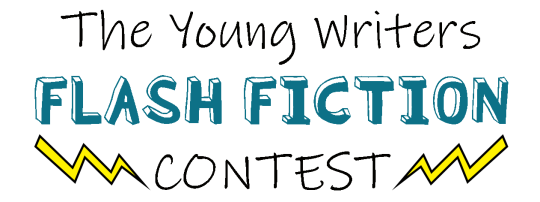
In May, we challenged our young writers to submit a 300 word flash fiction story containing the words “spider”, “rainbow”, and “cake”. From over 1,100 stupendous entries, we chose two Grand Prize Winners and three Runners-Up. We hope you enjoy reading them as much as we did!
I had given myself a nearly impossible goal. Headlines all across the world would read, “Pakistani girl becomes youngest person to climb Nepal’s Ama Dablam.” But things had gotten weird. There had been an unexpected blizzard. Separated from the group, I found myself scaling the 22,000 foot peak alone. I would not give up. I had just climbed a large ice wall, and made it to a ledge. Exhausted, I began trying to take deep breaths. That’s when I heard her angelic voice saying. “Just relax, you can float to the top.”
“What?”
“I’ll let you in on a secret. Perfectly at peace, you simply drift to the top. Try it.”
Tired, I thought it couldn’t hurt. Just as I began to close my eyes, I felt the first icy prick. I looked down to find my legs covered in tiny, crystalline spiders. Each blue spider appeared to be made of ice, with legs like prisms, reflecting every color of the rainbow. They felt like needles crawling over my hands and feet. I couldn’t move. They were taking me to him. As they brought me through large, ice doors into his palace, he said, “I’m so glad I found you.” He was dressed in white and wore a golden crown. “I need you to stay with me.” Why did I smell cake?
“I need to go.” I said. “The spiders hurt.”
“I can make them go away.” He waved his hand, and they disappeared.
“Please let me go.” I pleaded.
He answered harshly, “I need you to WAKE UP!”
I slowly opened my eyes. I heard the thumping of helicopter blades. “Thank God. I thought I lost you.” He said. I read the word “MEDIC” on his white coat and gold hat. The oxygen mask smelled like cake.
Special guest judge Amy Spalding said this about “Ama Dablam”: “This story sparkled with vibrant details, rich hints of backstory, and a twisty conclusion.“

Lana B. is a sixth grader at Woodlawn Middle School who is passionate about her writing. She loves to play hockey with her brother and teammates. Lana also enjoys playing electric guitar, and changing the lyrics of any song she hears so it becomes an ode to her dog. She feels compelled to do this because her dog is better than everyone else’s. Lana also has a hobby of making up words and convincing her unsuspecting family and friends to use them. She thinks it’s the nerp thing to do.
Tips on Writing the Opening Paragraph of Your First Story

Stuck on your opening? Don’t worry! Once upon a time young writer Ollie gave us a list of three tips to help us write our first page stress-free:
Writing the first page can be complicated. After all, it is the first part that readers read. If it’s monotonous, they might not read it. The start is an essential part of your story, but it can take a while to write an opening page. Today, I have found some tips and tricks on writing your first page.
Listing some ideas is a helpful tool to use when we are writing, and an even better way to help plan. List some ideas. Are there any special catchphrases you want to use? What’s happening in your story at the beginning? What is your opening sentence? How do you want to start your story? You can try to list out some ideas with these questions, plus many other ones that may pop up in your head!
If lists aren’t your thing, you might want to use an outline. Printing out one or drawing your own is a good idea. They don’t have to be fancy; you only need them to plan your first pages. Remember, if you are writing your first draft, it doesn’t have to be perfect. Most drafts have a lot of mistakes and parts that don’t make sense. The first draft is never perfect.
A panster is someone who doesn’t plan their stories. You don’t have to plan the beginning of your story. I never do, but that is okay. Set a 20-minute timer. Write the first pages of your story. They do not have to be perfect or even have excellent grammar. Remember, you are only trying to write a draft. This is not going to be the actual first page. After the timer rings, relax. Then look at your story so far. Is it going in the direction you want it to go? Doesn’t it follow the ideas you had in mind? If yes, you are set to go!
4. You can fix mistakes later.Remember, your first draft is never perfect.
If your first page is scrambling with mistakes, it’s okay. My stories end up with many grammar mistakes in the first draft. The best thing you can do is edit and revise. Then, you will have a perfect story in no time! If your story is starting a bit crumbly and weird, you can always rewrite it. But, remember, you can’t spend two years on the first page of a story. I learned that the hard way. Wait to edit and revise until after you are finished the book. That way, you know you have finished it, but you can also see if the book flows well.Those are my tips and tricks for writing the opening paragraphs of a story!
Stay safe and keep writing!

Ollie likes to read many books, but her favorite book series is Harry Potter. She is currently writing her first musical. She likes to write a variety of things, from poems to short stories. She is currently reading Physik by Angie Sage.
Photo by Glenn Carstens-Peters on Unsplash
July 10, 2020
A Beginning Is Not an End

As many of us know, the beginning of anything is often the hardest to write. Luckily, we have Wrimo
Mackenzie Bitz with us to today to share with us her top tips on how to write attention grabbing opening paragraph:
The end.
Not the sort of thing you’d expect to read in an opening, is it? But writing an opening can sometimes feel like a grim ending. Writers toil and suffer over openings because we’re told it’s necessary to catch a reader’s attention from the start. I’ve read from numerous agents that they’ll read the first line or page of a novel and quickly reject based off of how uninteresting or unoriginal it is.
Some of you may wonder, “How can this be? I’ve read plenty of openings that weren’t good. “Why can’t I be the exception?” Because you don’t want people to be bored from the very beginning. You’re better than that, and you should always hold your writing to a higher standard. After all, the beginning is a preview for what is to come—a taste of what the reader should want to experience. When you watch a movie trailer, the ones who made that trailer hope people will say, “Oh, that looks like a good movie.” Otherwise, no one will go to watch it. Your opening should resonate with intrigue, and there are many ways you can accomplish this.
Unless you have an amazing, surprising, or interesting opening already in mind, do what I do: Write the entire chapter or piece and then go back and tinker with the opening. You probably won’t get it right in the first or second draft, but you’ll get closer to where it needs to be. Really pinpoint where you want to start the story. Is it the most interesting part of a characters’ beginning? Is it a slow introduction? If it is a slow introduction, how can you make it enticing or interesting? When considering what the best openings are in a novel, it’s usually the one that makes you question things without sounding too confusing.
If you begin the novel within a fast-paced event for the sake of shock value, it could end up jarring readers instead. You want the readers to question things without getting frustrated. That could stem from a single, profound statement, or it could stem from one word. Whatever it is, make sure it’s relevant to what’s happening with the characters, and don’t make it too overwhelming or confusing.
For example: “Jenna was Diane’s favorite grandchild. It was too bad she killed her.”
With that sort of opening, possibly for a mystery or thriller novel, the readers question many things. Why was she killed? Was it an accident or purposeful? From there, readers will be motivated to keep reading.
A lot of writers stress over making their opening a spectacle, but it doesn’t need to be amazing. It just needs to be interesting, and usually how readers respond is what makes it amazing.
To summarize:
Start with an interesting paragraph, situation, or line.If you’re struggling to come up with something interesting, write the rest of the chapter and then come back to it. Try to write an opening that asks questions without being too overwhelming or confusing. Like with everything, all it takes is preparation and practice.With that said, the end.

Mackenzie Bitz is a writer with too many stories to tell and an avid reader with too many tears to contain. She has written many unpublished books and works every day to hone her craft and expand her literary knowledge. Currently, she attends the low-residency Creative Writing MFA program at Mississippi University for Women. In the future, she hopes to write and teach full-time.
Top photo by Danielle MacInnes on Unsplash.
An Insider’s Guide to Getting a Non-Fiction Book Deal
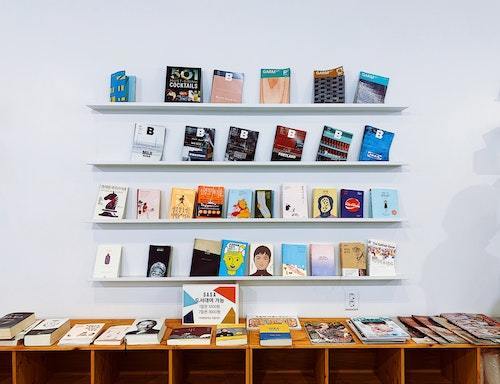
Every year, we’re lucky to have great sponsors for our nonprofit events. Editor Lydia Yadi collaborated with our sponsor Novlr to share some insider tips on how to publish your non-fiction manuscript. Novlr is a Camp NaNoWriMo 2020 sponsor.
You’ve thought of an amazing idea for a non-fiction book that you feel passionately you need to write. But how do you get an agent or publisher to believe in the idea too? Unlike fiction, you don’t necessarily need to have written the whole thing before getting a publisher on board.
In order to get your non-fiction book published, you will have to write a book proposal which gives publishers and editors a clear sense of what the book will be and who it will be for. The proposal needs to include all information publishers need to understand the project, and give an idea of what the final book will feel like as a reading experience. I am going to give you a head start with my insiders guide to writing a book proposal:
1. Summary and overviewStart with a one-sentence summary of what the book is and why it is going to sell. If you’re struggling with this, think about a question that this book will answer. Then expand this positioning statement to write a brief paragraph explaining the content and appeal of the book.
It’s incredibly important to explain your idea as clearly as possible, and have a strong idea whether your book is going to educate or entertain the reader and how. Is your book going to be an eye-opening commentary on current affairs canvassing interviews from leading voices in the field; an inspiring guide to adopting a new lifestyle or behavior filled with practical tools and exercises; or a gripping retelling of a well-known battle using original source material?
2. Chapter breakdownAfter the summary, you will need to write a chapter breakdown to illustrate the structure of the book and themes you will engage with. You should write a paragraph or two about what each chapter will cover. While brevity and clarity were important for the book summary, here you can go into much more detail to get the publisher excited by the project.
3. Sample writingBeyond the chapter breakdown, it’s very useful to include sample writing as this will give the publisher a greater sense of what your writing style is like and what the reading experience will be.
4. Know your audienceIt’s very important to consider who the target audience of the book is. In Stephen King’s book, On Writing, he described writing his first book with an “Ideal Reader” in mind. He imagined a woman of about thirty-five, well-educated and well-read, but not snooty, and always pressed for time, perhaps a healthcare professional or a teacher. This woman is reading the novel for pure entertainment whilst commuting on the bus.
Having an “Ideal Reader” in mind will help focus your thinking and positioning around the book. Be as precise as possible about who the core market will be. What else is this person into? How do they usually consume media? Do they like podcasts? Do they read one or fifteen books a year? Do they like reading eBooks or listening to Audiobooks? How do they discover books—in bookshops or by word of mouth?
5. Know the marketAs well as thinking about the target audience, it is important to look at similar books that are already available in the market. In your proposal you should explain what other books are already published in this space, and why your book is both different and better. Publishers want to be confident that you have read widely and really understand the genre you are aiming to publish into, so make sure you’ve spent time getting to know the market. If there are no similar books to yours, you might want to ask why. Though, of course, this might mean your book fills a gap in the market and you’re onto something!
6. In summaryWriting a strong book proposal is the best chance you have of securing a publishing deal so it’s important to spend the time and energy to make it as good as it can be. And remember, publishers are very busy people who might be reading as many as twenty proposals a week so make sure you grab their attention from the beginning to the end. Good luck!
Foolproof checklistHere’s a checklist of things to include in your proposal:
Positioning Statement Brief Summary Chapter BreakdownTarget AudienceAuthor BiographyCompeting Books Promotion and MarketingSpecifications: Timings, Word Count, FormatSample WritingWhy not create a new project in Novlr and give each chapter one of these headings and see where you get to? Then you can easily export to multiple formats and send it off! Novlr will be releasing a full blog series on getting published soon. To be first to hear about it, join the mailing list here.

Lydia Yadi is a Commissioning Editor at Penguin Random House and Novlr evangelist who has published four Sunday Times bestsellers. She commissions smart-thinking, personal development, business and psychology books, and acquires for the Penguin Business and Penguin Life imprints. Lydia likes publishing books that help people work and live better, whether that’s engaging with ideas on workplace culture, female empowerment or well-being. She publishes award winning journalists, high-profile CEOs and popular academics like Cal Newport, Marie Forleo, John Doerr, Whitney Wolfe Herd and Oliver Shah.
July 9, 2020
Christina Li is a student at Stanford University studying...
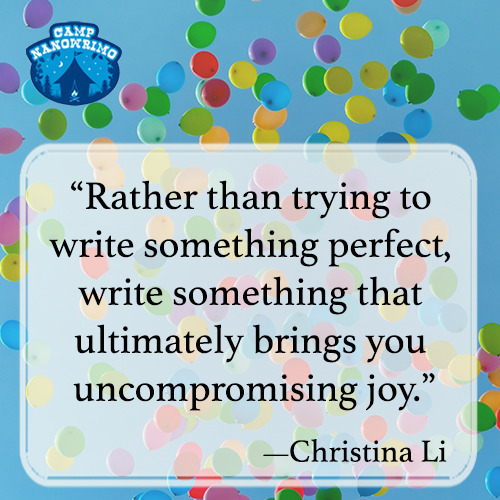
Christina Li is a student at Stanford University studying Economics. In her spare time, when she is not stressing over her latest stats problem set, she is writing up characters and stories for children and young adults, or perhaps procrastinating on said writing by drinking copious amounts of tea and binge-watching Avatar: the Last Airbender. She started NaNo-ing in sixth grade with the NaNoWriMo Young Writer’s Program and hasn’t stopped since. Her debut middle grade novel, Clues to the Universe, is coming out from HarperCollins/Quill Tree Books in January 2021.
Your Camp Care Package is brought to you by Camp NaNoWriMo. Sign up to receive more Camp Care Packages at nanowrimo.org!
Background image by Luca Upper on Unsplash.
Camp Pep: 3 Tips for Sticking to a Writing Routine

Camp NaNoWriMo is here—but if you’re having trouble finding time to sit down and concentrate on your writing don’t worry! Today we have Kristen Hall-Geisler with us to offer her suggestions for finding a routine in mist of all the everything going on around us:
This spring delivered upheaval after upheaval, in the form of a pandemic followed by global protests to protect and respect Black lives and a month of LGBTQ+ Pride. Times have been tough, but also filled with inspiration. People who’ve written several novels and people who’ve never attempted the form before are fired up to tell new stories. Camp NaNoWriMo is going to be amazing this year.
It’s always a challenge to maintain a writing practice, especially when schedules and routines might have flown out the window months ago. We’ve all heard “butt in chair,” meaning that the writing gets done when your butt is in the chair at your desk and the work is in front of you. But in case you need a little more guidance, here are three of my best tips for writers at any stage.
Productivity blogs and life hack sites sing the praises of waking up at 5:00 a.m. and getting in thousands of words before the birds wake up. This may be ideal for you, especially if you have young kids who wake up a little later. But it’s not ideal for everyone.
The trick is to experiment, and Camp NaNoWriMo is great for this. Take a week of Camp to try writing first thing in the morning (even if your “first thing” is more like 8:00 a.m.). Try reading for a few hours first, and then writing for an hour or two before lunch. Try the night owl life and begin writing after dinner or after everyone else in the house is in bed. When do you feel most energetic? When do you slip into that elusive state called “flow”? That’s your time.
Now that you’ve found it, don’t cling too tightly to it. If you miss a day, it’s okay. If you have to write later than usual because you have a Zoom meeting during your prime writing time, go with it. Do what you can to hit your daily goals, even if you have to write at a less than perfect time.
2. Find your tools, but don’t be superstitious.Some people write first drafts on paper with a fountain pen (I’m raising my hand). Some adore Scrivener and its many functions built specifically for writers. Some stick with good ol’ Word or Google Docs. There’s a tool for everyone and every stage of writing.
Again, Camp NaNoWriMo is a fun place to experiment. Write a chapter longhand and revise it by typing it up the next day. Dust off that vintage typewriter that’s been serving as décor for years. Type out a few paragraphs on your phone while on a walk. I’m currently coaching an author who has drafted a dozen short stories in the past six months using his notes app.
Once you’ve found the tools that help you create your magic, set them out so they’re in plain sight and waiting for you at your writing time. But don’t let the tools become more important than the writing! It’s great to have a favorite pen or app, but if that’s not available when inspiration strikes, use whatever is at hand. Capture the idea as completely as possible in whatever way you can and transfer it to your preferred medium whenever you can.
When you sign up for Camp NaNoWriMo, you get to choose the status of your project. My novel, for instance is in the planning stages. Yours might be ready for revisions. Then you pick your word count goal—how much do you want to get done in one month?
NaNoWriMo offers a benchmark with its 50,000-word goal. But since I’m still researching a historical period for this novel, I’m setting a much lower goal for Camp. If you’re revising, you have a word count already. Are you looking to shorten a bloated first draft? Or do you need to flesh out descriptions and
world building? Those will influence your goals. Break those goals down to daily totals and start ticking off those boxes. It feels so good to see yourself making progress every single day alongside so many other Campers. Remember, you can also change your goal if you need to.
Spending a week at camp with virtual writing buddies is a great way to stay on track and feel accountable to your goal. But as we’ve all experienced this year, plans can go sideways very fast. Issues can arise that need the attention of you and your community immediately. And you may be dealing with physical or mental health issues more this summer than ever.
Sticking to your Camp NaNoWriMo goals can act as a north star for keeping yourself focused when everything around you is in flux. But if Camp feels more like a burden than a relief at any point this month, don’t berate yourself or feel ashamed. November’s NaNoWriMo is right around the corner. We’re always happy to see you.

Kristen Hall-Geisler is a writer, editor, and publisher living in Oregon. She’s honed her research and interviewing skills with the New York Times, How Stuff Works, Popular Science, and more. She is the author of the historical novel Skull and Sidecar, and she’ll be publishing her translation of A Voyage Around My Room in September 2020. You can find her editing and coaching work at kristenhallgeisler.com and her publishing company at practicalfox.com. And she’s on NaNoWriMo as KristenHG.
Top photo by Jonny Caspari on Unsplash
July 8, 2020
5 Tips for Writing Your First Few Pages

Sometimes, starting a brand new project is the hardest part of writing. There are so many different ways a story could go when you’re staring at a blank page! Luckily, even if you’re having trouble, it’s never too late to start. Today, NaNoWriMo writer Kelly is here to share some tips on beginning:
Imagine the world’s most intense staring contest. That’s how I would describe my attempts to write my first paragraph or page. I stare at a sheet of paper, occasionally scribbling out some sentences and then immediately erasing them. It can get pretty frustrating as the minutes pass by and I’m still engaged in the staring contest.
I bet many writers out there have found themselves in a similar predicament from time to time. And since it’s the first week of Camp NaNoWriMo, taking on the challenge of writing your project’s opening sentences can be especially intimidating. To help you conquer those starting words so you can confidently embark on your writing journey, I’ll be sharing some tips that I’ve gathered from my own experiences:
1. Collect ideas.
Before you start writing, it can be helpful to have ideas of what you want your first page or paragraph to look like. One approach is to use the work of successful writers as a model. Observing the way writers begin their pieces can give you some ideas as to how to start yours (but please do not plagiarize!). Inspiration can also just come to you at the most random times. I recommend recording the ideas you come up with, so you don’t forget them and you can use them to guide you when you’re ready to start writing.
If your ideas are all over the place, it can be hard to write those first words. This is where an outline can come in handy. An outline breaks down your major ideas and organizes them, and it can be useful when you’re starting to write the introduction for your project. What your outline looks like is up to you, so if doodling helps you envision what your project’s first sentences look like, go for it!
Choose a space that makes you happy and boosts your productivity. You can put your favorite playlist on shuffle, go out in the sun, prepare some snacks, or you don’t have to do any of the things I just listed. Everyone has different preferences, so where you write is completely up to you.
4. Set a timer and just write.
This is a trustworthy method that I turn to when all other methods fail. I set the clock for twenty to thirty minutes and just write or type without stopping. During this time, I don’t worry about grammar, spelling, or making sure my sentences are exactly the way I want them to be. What I end up with may not always be good, but at least I have something to work with. And as the writer Jodi Picoult once said,“You can always edit a bad page. You can’t edit a blank page.”
5. Take a deep breath (or maybe a few) and smile!My best piece of advice for you is to write with joy. If you’re not writing with joy, then the process is going to be a lot more painful and a lot more frustrating. So if words are just not coming to you, then don’t force yourself to write. Take a break, do something you love doing, and come back when you’re ready and feeling inspired and joyful.

Kelly is from California and her written works have won awards on the local and national level. When she’s not experimenting with poetry and other forms of creative writing, she reads, plays the new Animal Crossing game, binge-watches Netflix, and consumes an exorbitant amount of chocolate.
Top photo by Kaitlyn Baker on Unsplash
July 7, 2020
"A helpful question to ask during the writing process is: what is the heart of your story? What are..."
-
Christina Li is a student at Stanford University studying Economics. In her spare time, when she is not stressing over her latest stats problem set, she is writing up characters and stories for children and young adults, or perhaps procrastinating on said writing by drinking copious amounts of tea and binge-watching Avatar: the Last Airbender. She started NaNo-ing in sixth grade with the NaNoWriMo Young Writer’s Program and hasn’t stopped since. Her debut middle grade novel, Clues to the Universe, is coming out from HarperCollins/Quill Tree Books in January 2021.
What’s at the heart of your story? Let Christina know, or thank her for her Camp Care Package.
Your Camp Care Package is brought to you by Camp NaNoWriMo. Sign up to receive more Camp Care Packages at nanowrimo.org!
Support the NaNoWriMo Young Writers Program… at Home
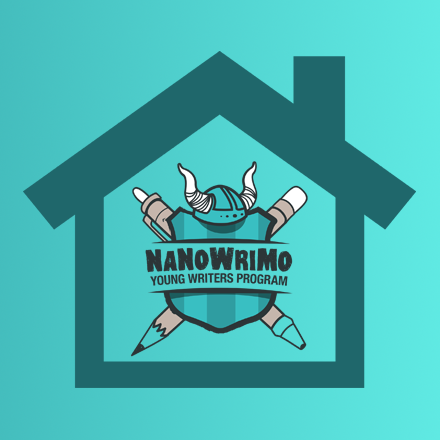 NaNoWriMo’s Young Writers Program works with more than 100,000 students and educators to help students develop a love for writing.
NaNoWriMo’s Young Writers Program works with more than 100,000 students and educators to help students develop a love for writing.As many educators and students prepare for the challenge of learning during a pandemic this coming school year, we’re preparing to partner with them. Please help us support these thoughtful, hard-working teachers and the students they’re guiding. From July 8 – 17, we’re aiming to raise $10,000 to support NaNoWriMo’s Young Writers Program.
Donate $25 to the Young Writers Program.
Your $25 donation will help us prepare our Young Writers Program as we anticipate more young writers and educators than ever to use our website outside of the classroom.
From July 8 – 17 only, you’ll also receive a special pack of “school supplies”, including a pencil, eraser, sticker, and button.
 What is NaNoWriMo’s Young Writers Program?
What is NaNoWriMo’s Young Writers Program?NaNoWriMo’s Young Writers Program supports young writers and the educators who guide them. We help young writers learn how to set their own goals and work toward them, develop a deeper understanding of the practice of writing, and give them access to a community of writers—in their classroom and online.
Young writers are actively engaged in their own learning. Our website helps students set their own writing goal, track their progress, and celebrate their achievements. They can do this in the classroom, from home, or wherever they might have internet access.
Young writers become a part of a greater writing community. Students receive pep talks from published authors, learning from and about writers like Sharon G. Flake, Gene Luen Yang, and Walter Dean Myers. They choose what they want to write about, practicing their writing, creativity, and imagination alongside an international community of young writers.
Young writers are taught by well-supported educators. We provide free Common-Core aligned curricula and workbooks for teachers. Our website provides online classrooms for educators, including progress-tracking tools for their students, a discussion platform, and a messaging system.
What is the Young Writers Program focusing on right now?We’re anticipating more students and educators using our site, and spending even more time on it than they usually do, as many schools are figuring out how they will adapt to the COVID-19 pandemic, especially in countries that continue to see rising cases, like the United States.
In preparation, we’re building new features for the site, adjusting the classroom kits we usually mail to educators (at no cost to them) so they’re better suited for distance learning, and preparing our budget for rising server costs.
We’d also like to translate our materials—in particular our workbooks—into Spanish for greater accessibility, both here in the United States and internationally.
All donations made from July 8 – July 17, 2020, will be restricted to the Young Writers Program at NaNoWriMo. This means that we’ll only use those funds for budget items associated with the Young Writers Program, including staff pay for employees who work directly with the Young Writers Program, costs for managing and hosting the YWP website, and costs for resources like the YWP classroom kits.
(Usually, any donations made through our store go toward our general operating costs—this is also incredibly valuable and appreciated. We’re restricting donations for this campaign to prepare YWP to both help educators and young writers through the unique challenges of this year, and set up YWP for long-term success!)
Donate $25 to the Young Writers Program or share the news about YWP!
July 6, 2020
Camp NaNoWriMo: The Musical! Meet the Musical
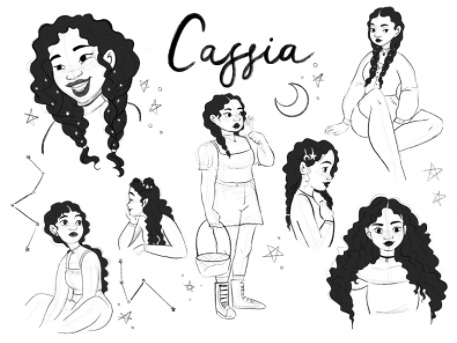
This July, we’re providing extra resources for anyone writing a musical during Camp NaNoWriMo! Camp Counselors Morgan Smith and Abigail Greenwood will be offering advice, tips, inspiration—and they’ll be writing right along with you. Today, they share a little about the musical they’re working on together during Camp:
Hey there, Campers!
I hope you’re having an absolutely amazing time at Camp so far! We’re so pumped to spend this month with you as your Counselors, as well as to be writing alongside you.
On that note, we’d love to introduce you to our musical Willow. This way you can get to know what we’re working on, as well as see what the brainstorming and development process looks like for us!
WillowSet in the fictional Averno Universe, Willow follows three main storylines, all of which take place under a willow tree at the edge of town:
1. Cassia and Grace: 2006.
Cassia is one of the forest’s daughters—children rescued from abusive or neglectful homes, raised in the woods, wild and feral. She has been in the woods longer than she can remember, and while she hasn’t aged like a normal girl, she knows that her time on earth is coming to an end. She goes to the edge of the forest one night to clear her head, try to ready herself for what’s about to happen. Instead of quiet contemplation, however, she happens across a girl with bright orange hair and a bottle of gin. Grace. Grace has a smile that feels like fire—warm and sharp and dangerous—and Cassia tells herself eternity can wait one more night.

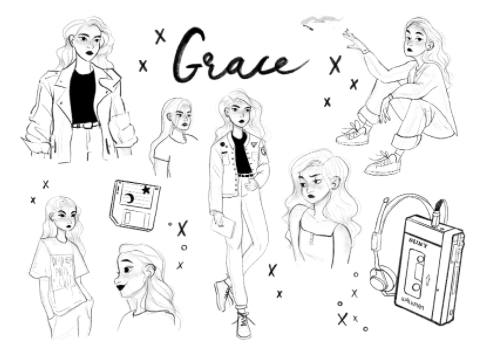
2. Adelaide and Beatrice: 2011.
Adelaide is a Good Southern Lady. She has always done what one Ought To Do. She got married at 15 to a respectable man. She got a respectable job at a bank. She had 4 lovely children. She’s had a reserved pew at church since she was 25. She even vacationed in Majorca once. But last year, after 62 years of marriage, her husband died. Her children are grown. And Adelaide has realized that she’s never really had an adventure. But all that changes one day on her way home from church, when Adelaide steps off the path—and wanders right on to Beatrice’s property.
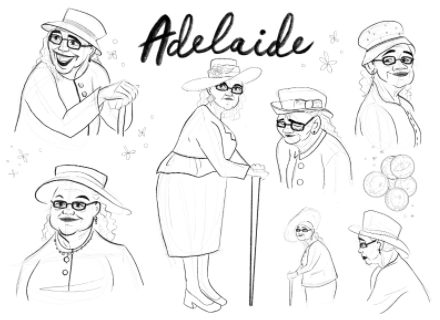

3. Meg: 2012. Meg is, to be quite honest, cooler than most of us could ever aspire to be. She has rainbow light-up sneakers and a butterfly backpack, and she goes to the willow tree to talk to her imaginary friend. Throughout the show, however, it becomes increasingly clear that her imaginary friend is talking back.

We are having so much fun building out this world and these characters, and we’re so excited to be getting started on the drafting process with Camp NaoWriMo!
If you’d like to follow along with what we’re up to, you can check out our musical here, and follow Morgan and Abigail on Instagram.
See you next week!
—Morgan

Morgan Smith is a writer, model, and activist, and social media influencer whose writings on have been published in the US and internationally, winning over 20 national awards. Morgan is the writer of Oceanborn, an internet-famous musical called “sweeping and confident” by the New York Times, and Averno, a multimedia franchise including 6 plays and musicals, virtual reality, epic poetry, comic books, radio theatre, and a concept album, culminating in a massive interlocking storyline that explores the politicization of women’s bodies. She is an experiential storytelling designer, a fandom creator, a legislative advocate, a medieval history literature specialist, and an avid proponent of fairy-tale revolution. You can find her on Instagram here and on Twitter here. You can find her musicals here.

Abigail Greenwood is a composer, lyricist, musician, and performer whose musicals went viral on Instagram, YouTube, and TikTok. Her first musical, Antonia (The Marie Antoinette Musical) was featured at the Florence Little Theatre in South Carolina when she was 15 years old. Her new musical, Two Maiden Ladies, a historical account of the true story of same-sex couple Charity and Sylvia, is currently searching for a new venue. She is also on the composer team of Averno, the multimedia musical franchise created by writing partner Morgan Smith. Abigail has also been writing novels and learning the art of songwriting her whole life. At 13, she won the “Top of the Pot” Songwriting competition against fellow adults and even former music teachers. She is experienced in teaching the art of writing musical theatre through her online intensive “Future Broadway Creators” she co-runs with writing partner Morgan Smith.
Chris Baty's Blog
- Chris Baty's profile
- 63 followers



